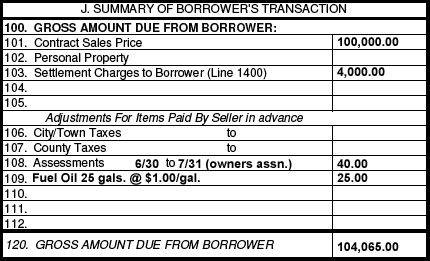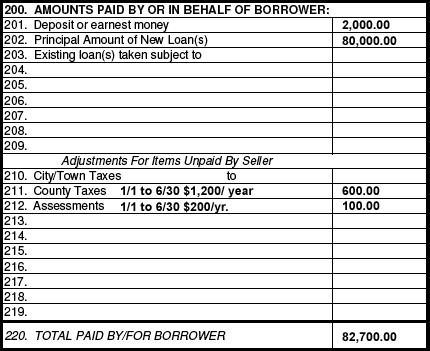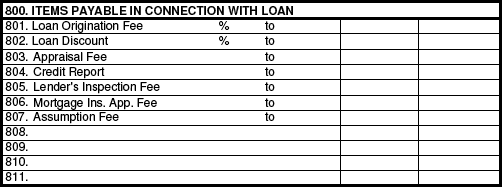Real Estate Settlements
Understanding the HUD-1 Settlement Statement Form
Calculating the Amount You Need at Settlement
The first page of the HUD-1 Settlement Statement summarizes all the costs and adjustments for the borrower and seller. Section J is the summary of the borrower’s transaction and Section K is the summary of the seller’s side of the transaction. You may receive a copy of the seller’s side, but it is not required.
Section 100 summarizes the borrower’s costs, such as the contract cost of the house, any personal property being purchased, and the total settlement charges owed by the borrower from Section L.
Beginning at line 106, adjustments are made for items (such as taxes, assessments, fuel) that the seller has previously paid. If you will benefit from these items after settlement, you will usually repay the seller for that portion of the cost.
Here is an example for you to use in making your own calculations:

Assume in this example, the cost of the house is $100,000 and the borrower’s total settlement charges brought from Line 1400 of Section L are $4,000. Assume that the settlement date is July 1. Here the borrower has agreed to pay the seller for the $40 Home Owners Association dues that have been paid for the month of July and for the 25 gallons of fuel oil left in the tank. This is added for a gross amount due from the borrower of $104,065.
Section 200 lists the amount paid by the borrower or on behalf of the borrower. This will include the deposit of earnest money you put down with the agreement of sale, the loan(s) you are getting and any loan you may be assuming.
Beginning at Line 210, adjustments are made for items that the seller owes (such as taxes, assessments) but for which you as the borrower will pay after settlement. The seller will usually pay you or credit you this portion at settlement.

In this example, assume the borrower paid an earnest deposit of $2,000 and is getting a loan for $80,000. A tax of $1200 and an assessment of $200 are due at the end of the year. The seller will pay the borrower for six months or one-half of this amount. Line 220 shows the total $82,700 to be paid by or for the borrower.
Section 300 reflects the difference between the gross amount due from the borrower and the total amount paid by/for the borrower. Generally, line 303 will show the amount of cash the borrower must bring to settlement.

In this example, the borrower must bring $21,365.00 to settlement.
Adjustments to Costs Shared by Buyer and Seller
At settlement it is usually necessary to make an adjustment between buyer and seller for property taxes and other expenses. The adjustments between buyer and seller are shown in Sections J and K of the HUD-1 Settlement Statement. In the example given above, the taxes, which are payable annually, had not yet been paid when the settlement occurs on July 1. The borrower will have to pay a whole year's taxes on the following December 1. However, the seller lived in the house for the first six months of the year. Thus, one half of the year's taxes are to be paid by the seller. Accordingly, lines 211 and 511 on the HUD-1 Settlement Statement would read as follows:
![]()
The borrower is given credit for this amount at the settlement and the seller will pay this amount or count it as a deduction from sums payable to the seller.
Similar adjustments are made for homeowner association dues, special assessments, and fuel and other utilities, although the billing periods for these may not always be on an annual basis. Be sure you work out these cost sharing arrangements or "prorations" with the seller before the settlement. You may wish to notify utility companies of the change in ownership and ask for a special reading on the day of settlement, with the bill for pre-settlement charges to be mailed to the seller at his or her new address or to the settlement agent. This will eliminate much confusion that can result if you are billed for utilities used when the seller owned the property.
Your Settlement Costs
A. Specific Settlement Costs
This part discusses the settlement services which you may be required to get and pay for and which are itemized in Section L of the HUD-1 Settlement Statement. You also will find a sample of the HUD-1 form to help you to understand the settlement transaction.
When shopping for settlement services, you can use this section as a guide, noting on it the possible services required by various lenders and the different fees quoted by service providers. Settlement costs can increase the cost of your loan, so compare carefully.
700. Sales/Broker's Commission: This is the total dollar amount of the real estate broker’s sales commission, which is usually paid by the seller. This commission is typically a percentage of the selling price of the home.

800. Items Payable in Connection with Loan: These are the fees that lenders charge to process, approve and make the mortgage loan:
801. Loan Origination: This fee is usually known as a loan origination fee but sometimes is called a "point" or "points." It covers the lender's administrative costs in processing the loan. Often expressed as a percentage of the loan, the fee will vary among lenders. Generally, the buyer pays the fee, unless otherwise negotiated.
802. Loan Discount: Also often called "points" or "discount points," a loan discount is a one-time charge imposed by the lender or broker to lower the rate at which the lender or broker would otherwise offer the loan to you. Each "point" is equal to one percent of the mortgage amount. For example, if a lender charges two points on a $80,000 loan this amounts to a charge of $1,600.
803. Appraisal Fee: This charge pays for an appraisal report made by an appraiser.
804. Credit Report Fee: This fee covers the cost of a credit report, which shows your credit history. The lender uses the information in a credit report to help decide whether or not to approve your loan and how much money to lend you.
805. Lender's Inspection Fee: This charge covers inspections, often of newly constructed housing, made by employees of your lender or by an outside inspector. (Pest or other inspections made by companies other than the lender are discussed in line 1302.)
806. Mortgage Insurance Application Fee: This fee covers the processing of an application for mortgage insurance.
807. Assumption Fee: This is a fee which is charged when a buyer "assumes" or takes over the duty to pay the seller’s existing mortgage loan.
808. Mortgage Broker Fee: Fees paid to mortgage brokers would be listed here. A CLO fee would also be listed here.

900. Items Required by Lender to Be Paid in Advance: You may be required to prepay certain items at the time of settlement, such as accrued interest, mortgage insurance premiums and hazard insurance premiums.
901. Interest: Lenders usually require borrowers to pay the interest that accrues from the date of settlement to the first monthly payment.
902. Mortgage Insurance Premium: The lender may require you to pay your first year’s mortgage insurance premium or a lump sum premium that covers the life of the loan, in advance, at the settlement.
903. Hazard Insurance Premium: Hazard insurance protects you and the lender against loss due to fire, windstorm, and natural hazards. Lenders often require the borrower to bring to the settlement a paid-up first year’s policy or to pay for the first year's premium at settlement.
904. Flood Insurance: If the lender requires flood insurance, it is usually listed here.

1000 - 1008. Escrow Account Deposits: These lines identify the payment of taxes and/or insurance and other items that must be made at settlement to set up an escrow account. The lender is not allowed to collect more than a certain amount. The individual item deposits may overstate the amount that can be collected. The aggregate adjustment makes the correction in the amount on line 1008. It will be zero or a negative amount.

1100. Title Charges: Title charges may cover a variety of services performed by title companies and others. Your particular settlement may not include all of the items below or may include others not listed.
1101. Settlement or Closing Fee: This fee is paid to the settlement agent or escrow holder. Responsibility for payment of this fee should be negotiated between the seller and the buyer.
1102-1104. Abstract of Title Search, Title Examination, Title Insurance Binder: The charges on these lines cover the costs of the title search and examination.
1105. Document Preparation: This is a separate fee that some lenders or title companies charge to cover their costs of preparation of final legal papers, such as a mortgage, deed of trust, note or deed.
1106. Notary Fee: This fee is charged for the cost of having a person who is licensed as a notary public swear to the fact that the persons named in the documents did, in fact, sign them.
1107. Attorney's Fees: You may be required to pay for legal services provided to the lender, such as an examination of the title binder. Occasionally, the seller will agree in the agreement of sale to pay part of this fee. The cost of your attorney and/or the seller’s attorney may also appear here. If an attorney's involvement is required by the lender, the fee will appear on this part of the form, or on lines 1111, 1112 or 1113.
1108. Title Insurance: The total cost of owner's and lender's title insurance is shown here.
1109. Lender's Title Insurance: The cost of the lender’s policy is shown here.
1110. Owner's (Buyer’s) Title Insurance: The cost of the owner's policy is shown here.

1200. Government Recording and Transfer Charges: These fees may be paid by you or by the seller, depending upon your agreement of sale with the seller. The buyer usually pays the fees for legally recording the new deed and mortgage (line 1201). Transfer taxes, which in some localities are collected whenever property changes hands or a mortgage loan is made, can be quite large and are set by state and/or local governments. City, county and/or state tax stamps may have to be purchased as well (lines 1202 and 1203).

1300. Additional Settlement Charges:
1301. Survey: The lender may require that a surveyor conduct a property survey. This is a protection to the buyer as well. Usually the buyer pays the surveyor's fee, but sometimes this may be paid by the seller.
1302. Pest and Other Inspections: This fee is to cover inspections for termites or other pest infestation of your home.
1303-1305. Lead-Based Paint Inspections: This fee is to cover inspections or evaluations for lead-based paint hazard risk assessments and may be on any blank line in the 1300 series.

Paid Outside Of Closing ("POC"): Some fees may be listed on the HUD-1 to the left of the borrower’s column and marked "P.O.C." Fees such as those for credit reports and appraisals are usually paid by the borrower before closing/settlement. They are additional costs to you. Other fees such as those paid by the lender to a mortgage broker or other settlement service providers may be paid after closing/settlement. These fees are usually included in the interest rate or other settlement charge. They are not an additional cost to you. These types of fees will not be added into the total on Line 1400.

